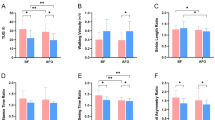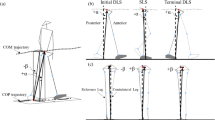Abstract
The purpose of this study was to compare the effects of different ankle and knee supports on balance in early ambulation of post-stroke hemiplegic patients. This is a randomized experimental study. The study sample included 20 hemiplegic patients who were able to stand with support and who had been diagnosed with a cerebrovascular accident within the last month. A knee immobilization brace (KIB) was first placed on each individual (first application), followed by placement of knee immobilizer brace and Foot Lifter Orthosis ® (FLO) (second application), and lastly, placement of KIB and rigid taping (RT) (third application). The balance parameters of the patients were evaluated using the Korebalance system. The mean age of the patients was 65.1 ± 4.7 years, and the mean number of days that had passed since stroke occurred was 14.6 ± 4.97. In calculating the front/left balance scores of the applications, statistically significant differences were observed in the comparisons of all three supports and first–second applications performed (p = 0.041 and p = 0.021, respectively). Regarding the total scores between the applications, statistically significant differences were determined in balance in the comparisons on all three supports, in comparisons between the first and second applications, and in the comparisons between the second and third applications (p = 0.004, p = 0.007, and p = 0.001, respectively). Based on the findings from this study, it is recommended that the use of a knee immobilizer brace in combination with a foot lifter orthosis for post-stroke hemiplegic patients in early ambulation can lead to considerably improved standing balance.

Similar content being viewed by others
References
Feigin VL, Lawes CM, Bennett DA, Barker-Collo SL, Parag V (2009) Worldwide stroke incidence and early case fatality reported in 56 population-based studies: a systematic review. Lancet Neurol 8(4):355–369. doi:10.1016/S1474-4422(09)70025-0
Colaianni V, Mazzei R, Cavallaro S (2016) Copy number variations and stroke. Neurol Sci 37(12):1895–1904. doi:10.1007/s10072-016-2658-y
Writing Group M, Lloyd-Jones D, Adams RJ, Brown TM, Carnethon M, Dai S, De Simone G, Ferguson TB, Ford E, Furie K, Gillespie C, Go A, Greenlund K, Haase N, Hailpern S, Ho PM, Howard V, Kissela B, Kittner S, Lackland D, Lisabeth L, Marelli A, McDermott MM, Meigs J, Mozaffarian D, Mussolino M, Nichol G, Roger VL, Rosamond W, Sacco R, Sorlie P, Roger VL, Thom T, Wasserthiel-Smoller S, Wong ND, Wylie-Rosett J, American Heart Association Statistics C Stroke Statistics S (2010) Heart disease and stroke statistics--2010 update: a report from the American Heart Association. Circulation 121(7):e46–e215. doi:10.1161/CIRCULATIONAHA.109.192667
Dogru Huzmeli E, Yildirim SA, Kilinc M (2017) Effect of sensory training of the posterior thigh on trunk control and upper extremity functions in stroke patients. Neurol Sci 38(4):651–657. doi:10.1007/s10072-017-2822-z
Bertani R, Melegari C, De Cola MC, Bramanti A, Bramanti P, Calabro RS (2017) Effects of robot-assisted upper limb rehabilitation in stroke patients: a systematic review with meta-analysis. Neurol Sci. doi:10.1007/s10072-017-2995-5
Nolan KJ, Yarossi M (2011) Preservation of the first rocker is related to increases in gait speed in individuals with hemiplegia and AFO. Clin Biomech (Bristol, Avon) 26(6):655–660. doi:10.1016/j.clinbiomech.2011.03.011
Badke M, DiFabio R (1990) Balance deficits in patients with hemiplegia: considerations for assessment and treatment. In: Balance: proceedings of the APTA forum. American Physical Therapy Association, Alexandria, p 3–90
de Wit DC, Buurke JH, Nijlant JM, Ijzerman MJ, Hermens HJ (2004) The effect of an ankle-foot orthosis on walking ability in chronic stroke patients: a randomized controlled trial. Clin Rehabil 18(5):550–557. doi:10.1191/0269215504cr770oa
Padua L, Doneddu PE, Iodice F, Coraci D, Rossini PM (2017) Transfer to inpatient rehabilitation facilities after neurological admission. Neurol Sci 38(4):687–688. doi:10.1007/s10072-016-2772-x
Yamanaka T, Akashi K, Ishii M (2004) Stroke rehabilitation and long leg brace. Top Stroke Rehabil 11(3):6–8. doi:10.1310/G8RF-312L-G6FW-A8JW
Shinohara Y, Yanagihara T, Abe K, Yoshimine T, Fujinaka T, Chuma T, Ochi F, Nagayama M, Ogawa A, Suzuki N, Katayama Y, Kimura A, Liu M, Eto F (2011) VII. Rehabilitation. J Stroke Cerebrovasc Dis 20(4 Suppl):S145–S180. doi:10.1016/j.jstrokecerebrovasdis.2011.05.014
Mizuno M, Saitoh E, Iwata E, Okada M, Teranishi T, Itoh M, Hayashi M, Oda Y (2005) The development of a new posterior strut AFO with an adjustable joint: its concept and a consideration of basic function. Bull Jpn Soc Prosthetics Orthot 21(4):225–233. doi:10.11267/jspo1985.21.225
Pohl M, Mehrholz J (2006) Immediate effects of an individually designed functional ankle-foot orthosis on stance and gait in hemiparetic patients. Clin Rehabil 20(4):324–330. doi:10.1191/0269215506cr951oa
Tyson SF, Kent RM (2013) Effects of an ankle-foot orthosis on balance and walking after stroke: a systematic review and pooled meta-analysis. Arch Phys Med Rehabil 94(7):1377–1385. doi:10.1016/j.apmr.2012.12.025
Simons CD, van Asseldonk EH, van der Kooij H, Geurts AC, Buurke JH (2009) Ankle-foot orthoses in stroke: effects on functional balance, weight-bearing asymmetry and the contribution of each lower limb to balance control. Clin Biomech (Bristol, Avon) 24(9):769–775. doi:10.1016/j.clinbiomech.2009.07.006
Brumett D Sr, Rouhe SA, Struven JB, Trindade C (2005) Treatment of foot drop using a dynamic, non-rigid dorsiflexion foot lifter. Orthopedics 28(6):551–554
Shaheen AF, Villa C, Lee YN, Bull AM, Alexander CM (2013) Scapular taping alters kinematics in asymptomatic subjects. J Electromyogr Kinesiol 23(2):326–333. doi:10.1016/j.jelekin.2012.11.005
Host HH (1995) Scapular taping in the treatment of anterior shoulder impingement. Phys Ther 75(9):803–812
McCaw ST, Cerullo JF (1999) Prophylactic ankle stabilizers affect ankle joint kinematics during drop landings. Med Sci Sports Exerc 31(5):702–707
Hyun KH, Cho HY, Lim CG (2015) The effect of knee joint mulligan taping on balance and gait in subacute stroke patients. J Phys Ther Sci 27(11):3545–3547. doi:10.1589/jpts.27.3545
Ewoldt JK, Lazzaro EC, Roth EJ, Suresh NL (2016) Quantification of a single score (1+) in the Modified Ashworth Scale (MAS), a clinical assessment of spasticity. Conf Proc IEEE Eng Med Biol Soc 1737-1740. doi:10.1109/EMBC.2016.7591052
Lindgren I, Jonsson AC, Norrving B, Lindgren A (2007) Shoulder pain after stroke: a prospective population-based study. Stroke 38(2):343–348. doi:10.1161/01.STR.0000254598.16739.4e
Park GT, Kim M (2016) Correlation between mobility assessed by the Modified Rivermead Mobility Index and physical function in stroke patients. J Phys Ther Sci 28(8):2389–2392. doi:10.1589/jpts.28.2389
Cachupe WJ, Shifflett B, Kahanov L, Wughalter EH (2001) Reliability of biodex balance system measures. Meas Phys Educ Exerc Sci 5(2):97–108
Wang RY, Yen L, Lee CC, Lin PY, Wang MF, Yang YR (2005) Effects of an ankle-foot orthosis on balance performance in patients with hemiparesis of different durations. Clin Rehabil 19(1):37–44. doi:10.1191/0269215505cr797oa
Carse B, Bowers R, Meadows BC, Rowe P (2015) The immediate effects of fitting and tuning solid ankle-foot orthoses in early stroke rehabilitation. Prosthetics Orthot Int 39(6):454–462. doi:10.1177/0309364614538090
Maguire C, Sieben JM, Frank M, Romkes J (2010) Hip abductor control in walking following stroke—the immediate effect of canes, taping and TheraTogs on gait. Clin Rehabil 24(1):37–45. doi:10.1177/0269215509342335
Jang J (2007) Effects of adaptation on the ability to balance taping kineshio therapy in hemiplegic patients. J Sport Soc 18:811–818
Maeshima S, Okazaki H, Okamoto S, Mizuno S, Asano N, Maeda H, Masaki M, Matsuo H, Tsunoda T, Sonoda S (2015) A comparison of knee-ankle-foot orthoses with either metal struts or an adjustable posterior strut in hemiplegic stroke patients. J Stroke Cerebrovasc Dis 24(6):1312–1316. doi:10.1016/j.jstrokecerebrovasdis.2015.02.003
Kaya P, Alemdaroglu I, Yilmaz O, Karaduman A, Topaloglu H (2015) Effect of muscle weakness distribution on balance in neuromuscular disease. Pediatr Int 57(1):92–97. doi:10.1111/ped.12428
Acknowledgements
We would like to thank the neurologist Suat Kamışlı, who helped us access the persons included in the study during the collection of the data.
Author information
Authors and Affiliations
Corresponding author
Ethics declarations
Funding
The authors received no financial support for the research, authorship and/or publication of this article.
Conflict of interest
The authors declare that they have no conflict of interest.
Rights and permissions
About this article
Cite this article
Talu, B., Bazancir, Z. The effect of different ankle and knee supports on balance in early ambulation of post-stroke hemiplegic patients. Neurol Sci 38, 1811–1816 (2017). https://doi.org/10.1007/s10072-017-3065-8
Received:
Accepted:
Published:
Issue Date:
DOI: https://doi.org/10.1007/s10072-017-3065-8




